The 9.7" iPad Pro Review
by Brandon Chester on June 1, 2016 9:00 AM ESTSystem Performance
Like the larger iPad Pro, the 9.7" iPad Pro uses Apple's A9X SoC. Apple is never very forthcoming with details like the clock speed for the CPU, GPU, and amount of DRAM. What we can determine about the SoC is that Apple has maintained the 2.2GHz maximum clock speed from the larger iPad Pro, while reducing clocks on the GPU and dropping to 2GB of LPDDR4 RAM.
The RAM situation on the 9.7" iPad Pro is somewhat surprising for a few different reasons. In their always-excellent teardown, the iFixit crew discovered that the smaller iPad Pro only had one Samsung 2GB LPDDR4 memory chip. This explains how Apple scaled down from 4GB to 2GB - the larger iPad Pro had two chips - but it also means that Apple has changed the amount of memory bandwidth available to the A9X SoC as well.
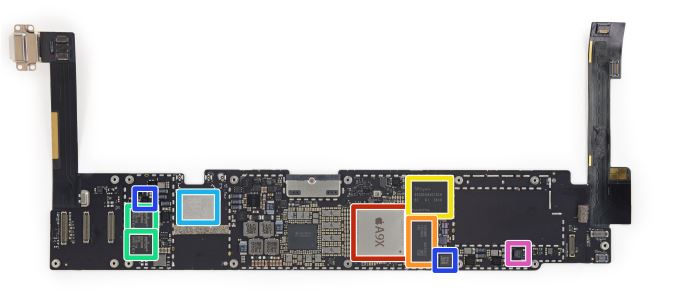
9.7" iPad Pro Logic Board (Image Courtesy iFixit)
To date, all Apple X-series SoCs have shipped with a larger 128-bit memory bus, and until now, Apple always fully populated that bus. So the 9.7" iPad Pro is an outlier in that regard, as this is the first time we've seen an X-series SoC with only the first 64-bit half wired up to a single memory chip in this fashion. In that respect it's a surprising decision from Apple, in part because of the importance of memory bandwidth in feeding the large, powerful GPUs on the X-series SoCs.
Consequently there is going to be more to the 9.7" iPad Pro than just the original Pro in a smaller chassis. The 9.7" iPad Pro should match the larger model in anything that depends heavily on CPU speed or memory bandwidth, while falling behind to some degree in GPU-bound tests. The 12 cluster PowerVR Series7XT GPU inside A9X will be having to make do with less memory bandwidth, though offset to some degree by the lower resolution of the screen.
With the above in mind, I quickly benchmarked the 9.7" iPad Pro on a couple of our memory bandwidth benchmarks. The results are somewhat inconclusive.
| Geekbench 3 Memory Bandwidth Comparison (1 thread) | ||||||
| Stream Copy | Stream Scale | Stream Add | Stream Triad | |||
| 9.7" iPad Pro | 17.1 GB/s | 11.5 GB/s | 12.9 GB/s | 12.8 GB/s | ||
| 12.9" iPad Pro | 20.8 GB/s | 15.0 GB/s | 15.3 GB/s | 15.1 GB/s | ||
I say "inconclusive" because although the 9.7" iPad Pro consistenly scores lower in Geekbench 3's memory bandwidth benchmarks and other memory benchmarks, it's never a 50% drop as we get on paper. In practice these numbers are far from the maximum memory bandwidth A9X is capable of, and I suspect that the CPU paths simply aren't wired in such a fashion that they can fully saturate A9X, especially given the fact that it's the GPU that needs the bandwidth more. So although we see some impact of the narrower memory bus in dedicated memory bandwidth benchmarks, these can't paint a very clear picture. It's going to be our high level GPU performance benchmarks that really give us an idea of the impact of reduced memory bandwidth.
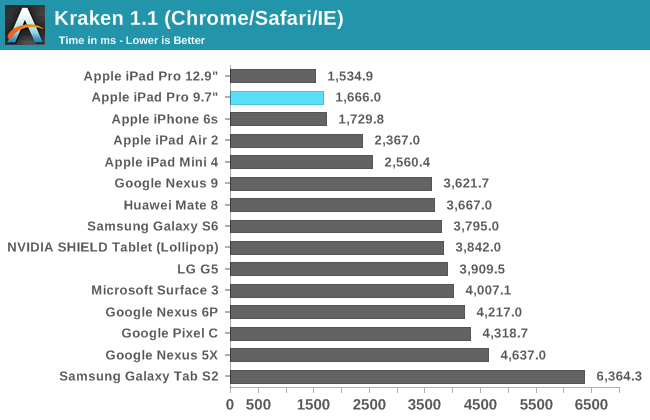
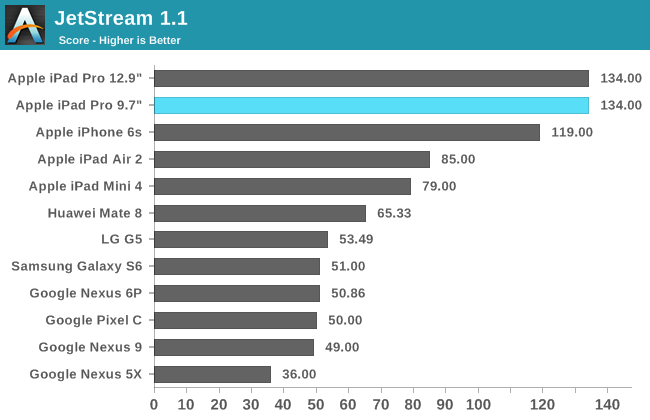
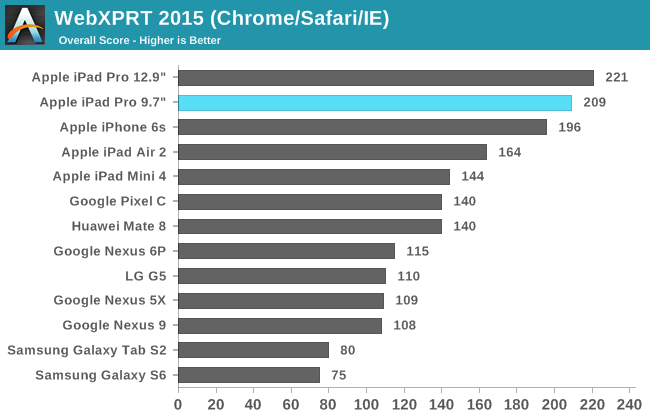
With the 9.7" iPad Pro having the same two 2.2GHz Apple Twister cores as the 12.9" model, it's no surprise to see the two neck and neck in our browser tests. In Jetstream 1.1 the two achieve the exact same score, while in the other two tests the 9.7" model is a bit slower, but with the gap being small enough to attribute to testing variance. With A9X Apple moved back to a dual-core CPU from A8X's tri-core CPU, with the move to TSMC's 16nm FinFET process allowing peak clock speeds to go up by 700MHz. Because JavaScript performance is mostly bound by a device's single threaded performance, A9X came with a significant performance uplift during web browsing. Given that the 12.9" iPad Pro offered the best web browsing performance of a mobile device, bringing that performance to the 9.7" iPad makes for a notable improvement over the performance of the iPad Air 2.
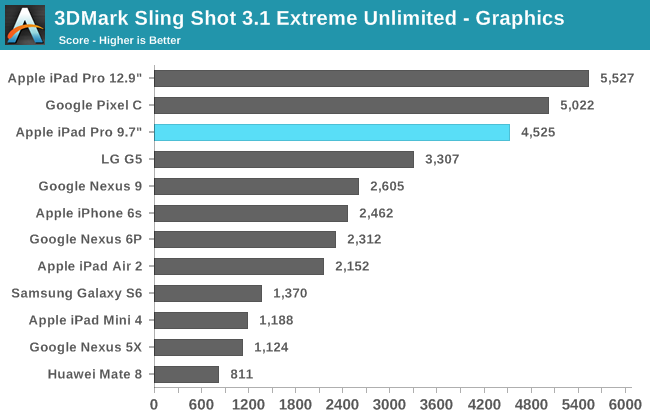
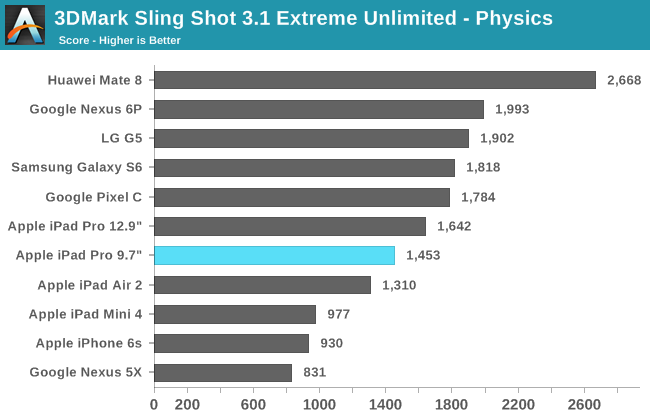
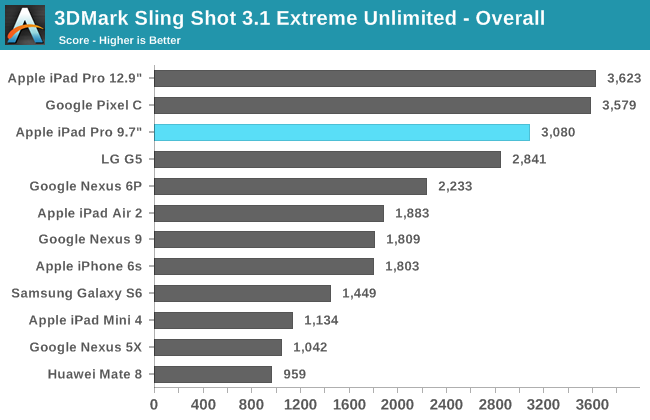
The 9.7" iPad Pro does well in 3DMark's graphics test, but like Ice Storm it doesn't do well in the physics test. It seems that this test is programmed in a similar way to Ice Storm, and in that sense I'm not sure how representative the physics test is of real-world performance because with an actual mobile game you wouldn't use highly random memory access and data structures with heavy memory dependencies when it would perform very poorly on your target devices. In any case, you can see that the 9.7" iPad Pro places third overall, with the 12.9" model at the top of the chart and the Pixel C coming right behind it.
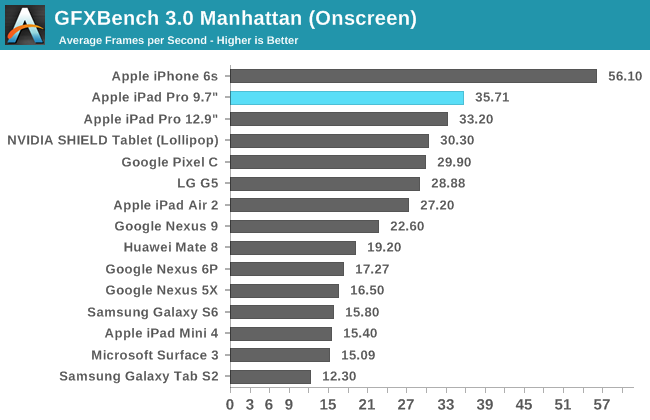
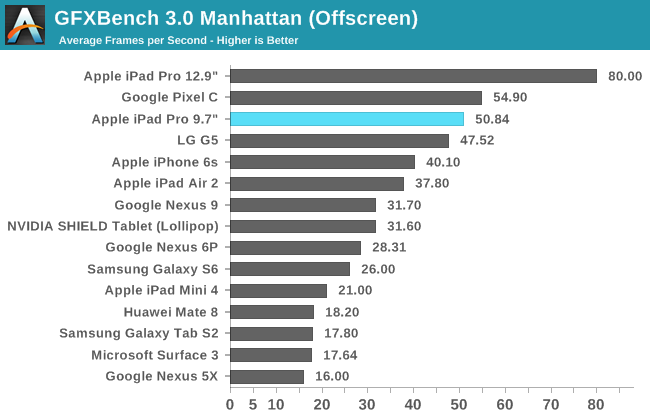
GFXBench 4.0 Car Chase hasn't made its way to iOS yet, and so for now we're still using GFXBench 3.0 Manhattan for iOS devices. Given that the iPhone 6s is the only phone that hits Vsync in this test, it's still a very relevant benchmark in how it represents the level of visual fidelity that a mobile game can currently have on high end devices while still performing well. In the off screen test we can see the impact of the 9.7" iPad Pro's lower clocked GPU combined with the reduced memory bandwidth,, with the smaller iPad performing around 37% lower than that of the 12.9" iPad Pro. The on screen test tells an interesting story though. Both models of the iPad Pro have roughly the same performance at their native resolutions in this test, which could indicate that Apple was targeting the same performance relative to the display resolution when configuring A9X and its memory, in order to manage heat and energy usage in a smaller iPad Pro.
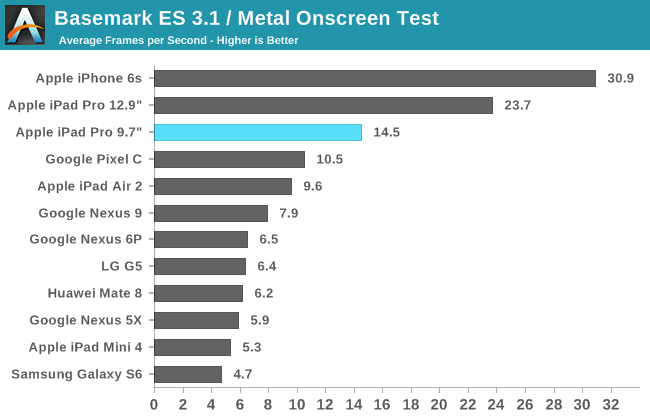
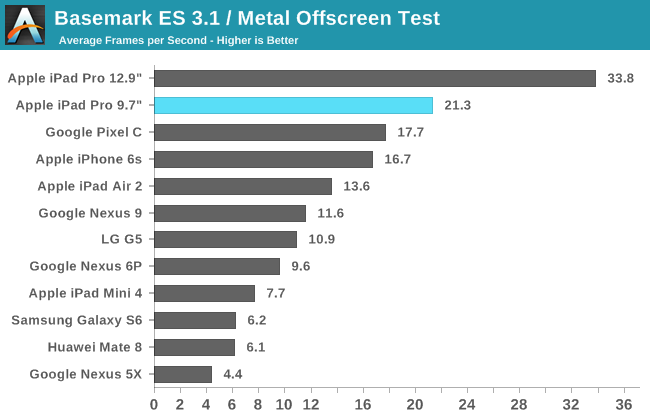
While I didn't have enough data to use BaseMark ES 3.1 at the time of my iPhone SE review, we've since tested enough older devices to deploy it. One could think of this as the successor to BaseMark X, which we retired some time ago before we officially deployed a new mobile test suite for 2016. Once again, both models of the iPad Pro sit above the other tablets on the chart. The iPhone 6s places first in the on screen test due to its relatively low resolution, but without that there the iPads would hold the top two spots in both tests.
NAND Performance
Something that Apple publicized with their A9 and A9X SoCs is improved NAND performance. NAND performance isn't discussed very much in reviews, but it's a very critical aspect of device performance and issues with it tend to cause a device's performance to crash months down the line rather than right off the bat, which makes it something of an invisible problem if you don't look for it during a review. We've seen previously that Apple has been using their own SSD controller in the current generation of iOS devices, and the 9.7" iPad Pro continues this.
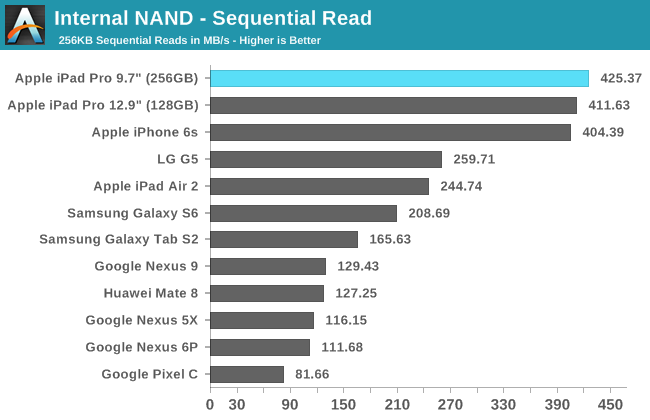
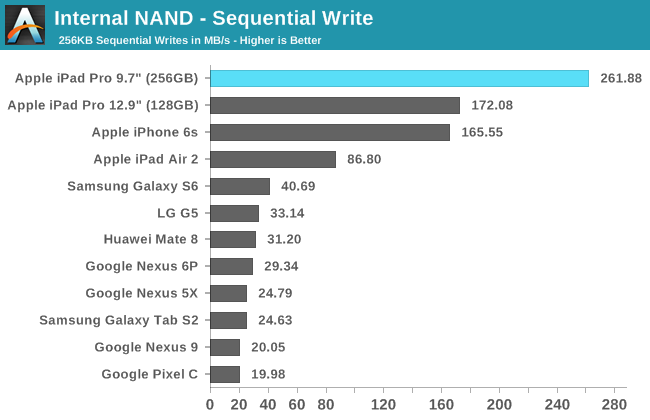
For this review I was sampled the 256GB model of the 9.7" iPad Pro. Because SSDs exploit parallelism heavily to improve performance, a 256GB iPad could improve NAND write performance over the lower-capacity models if it has a greater number of dies. In this case we see that sequential read performance improves a bit, while sequential writes improve dramatically as expected. There's not a lot to say here, as Apple has an enormous lead over the competition in this area.










144 Comments
View All Comments
ImSpartacus - Wednesday, June 1, 2016 - link
Whew, finally! Looks like is was worth the wait though. :Pdamianrobertjones - Wednesday, June 1, 2016 - link
I sold my iPad mini 4, just to get one of these, as I'd previously owned the Air 2 and I simply couldn't justify the extra cost. Sure, of course, it is a nice device, but all I did was launch SimCity Builit (Which didn't seem to load faster) and mess around. For all serious tasks I have the Surface Pro 3.It's a lot... for not a lot really. Plus, seeing as the Surface line was initially blasted for not including a stylus/keyboard, it's annoying that Apple sell them for MORE (I think) than the MS versions.
The charts do not include the Surface pro 4 for screen quality. Selective information?
All in all, although nice, it simply wasn't worth the cash (to me).
Brandon Chester - Wednesday, June 1, 2016 - link
The Surface Pro 4 technically doesn't use the same display tests in all cases, such as GMB, as we use a reduced pattern set for mobile. I can add the results that are comparable to the charts. I think as far as size and price go the Surface 3 is the more relevant comparison though, and that was there.dsumanik - Wednesday, June 1, 2016 - link
Gimme a break chester, this is apple's latest and greatest tablet and should be compared head to head with microsoft's latest, on all fronts. That's what apple was shooting for with this product.In fact,
In apples very own keynote they raved about the amount of PC user's that were ditching desktops for an iPad, which is ridiculous because anyone owning a 7 year old PC is not going to be looking to spend 360 bucks just for a keyboard and stylus... LOL!
Brett Howse - Wednesday, June 1, 2016 - link
I'm not sure exactly what your complaint is here. The Surface 3 is a much closer touch point in almost every aspect except for performance. But regardless, we have our online Bench where you can always compare any device and I've even done it for you:http://www.anandtech.com/bench/product/1697?vs=157...
The larger iPad Pro was compared to the Surface Pro 4, as it should be. We keep an online database though so if you want to do any extra comparisons its very simple. Bench is a link at the top of the page.
nikon133 - Thursday, June 2, 2016 - link
It is being marketed as a "Pro" line product... thus it should be compared to other Pro tablets.I haven't read article yet... but I'm presuming tablet runs on platform comparable to larger iPad Pro. I don't think that screen size alone should be the differentiating factor. HP Elitebooks come with screens from 12 to 15.6", for example... can't recall anyone saying that 12" Elitebook is not a business-class laptop just because it is smaller?
dsumanik - Sunday, June 5, 2016 - link
The complaint is that there is inherent apple bias in the that article has extended to the benchmarks.The surface pro 4 may very well be inferior. But this "review" is deceptive. Why not just follow Apple marketing guidelines and compare the ipad pro to "5 year old pc's everyone is leaving for iPad".
Why not just put a single benchmark of a 486 laptop and call it the best?
Vigilant007 - Sunday, August 7, 2016 - link
I can understand not being happy with facets of the review. Chalking up your concerns to "you're a horrible person" isn't the most constructive line of dialogue.It looks like your response was nicely responded to. I'd encourage more discussion instead of tin foil hat guttural response. I think we get it from your responses that your using global stereotypes to paint a picture that everything is inferior to what you have.
All of that said, I haven't been a fan of the Microsoft Surface line till this generation. There's a certain rhythm of finally "getting it" in terms of fit and finish that I don't think Microsoft has had in hardware till this year. The Surface Pro and SurfaceBook are both impressive devices. If what I wanted as an individual could be served by the Windows ecosystem (phone through tablet) I would be giving it a much more serious look.
Apples attitude towards user experience and hardware has been, and still is to a certain degree incredibly different then Microsoft and most other OEMs. You can call it "bad" as much as you want, and that's your right to do so. I have a few iPads in my house, and got one for my little brother to use in college. They are arguably the best overall tablet on the market from hardware onto ecosystem.
Thanks for peeing in the punch bowl because someone doesn't agree with you hence becoming a "horrible person".
KPOM - Wednesday, June 1, 2016 - link
It's $260 for the keyboard and pencil.dsumanik - Sunday, June 5, 2016 - link
not in canada, they gouge us. $360.